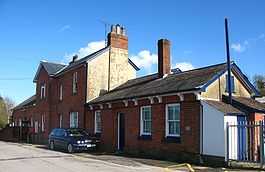Tisbury railway station
| Tisbury | |
|---|---|
 | |
| Location | |
| Place | Tisbury |
| Local authority | Wiltshire |
| Coordinates | 51°03′40″N 2°04′44″W / 51.061°N 2.079°WCoordinates: 51°03′40″N 2°04′44″W / 51.061°N 2.079°W |
| Grid reference | ST945290 |
| Operations | |
| Station code | TIS |
| Managed by | South West Trains |
| Number of platforms | 1 |
|
Live arrivals/departures and station information from National Rail Enquiries | |
| Annual rail passenger usage* | |
| 2002/03 | 69,915 |
| 2004/05 |
|
| 2005/06 |
|
| 2006/07 |
|
| 2007/08 |
|
| 2008/09 |
|
| 2009/10 |
|
| 2010/11 |
|
| 2011/12 |
|
| History | |
| Original company | Salisbury and Yeovil Railway |
| Pre-grouping | London and South Western Railway |
| Post-grouping | Southern Railway |
| 1859 | Opened |
| 1967 | Line singled |
| 1986 | New loop opened |
| National Rail – UK railway stations | |
| A B C D E F G H I J K L M N O P Q R S T U V W X Y Z | |
| * Annual estimated passenger usage based on sales of tickets in stated financial year(s) which end or originate at Tisbury from Office of Rail Regulation statistics. Methodology may vary year on year. | |
|
| |
Tisbury railway station serves the village of Tisbury in Wiltshire, England. Opened in 1859, it is currently managed by South West Trains and is on its London Waterloo to Exeter line, 96.2 miles (154.8 km) from London.
History
The Salisbury and Yeovil Railway (S&YR) opened Tisbury railway station with the first section of its line, from Salisbury to Gillingham, on 2 May 1859. At first only passengers were catered for, but goods traffic started on 1 September 1860. The main goods yard and warehouse was on the north side of the line at the west end of the station, but some sidings were also added on the opposite side of the line. Initially the railway had just a single track but a passing loop and two platforms were provided at Tisbury. The whole line was double track by 1870 and a signal box was opened here in 1875.[1]
The S&YR never operated any trains, instead they were provided by the London and South Western Railway, which bought out the S&YR in 1878. In 1923 this became part of the Southern Railway, which in turn was nationalised in 1948 to become the Southern Region of British Railways. During all this time there were only incremental changes at Tisbury, but this was to change from 1963. In that year the line was transferred to the Western Region, and the Reshaping of British Railways report was published. The smaller stations were soon closed, and most trains only ran as far as Exeter St Davids, instead of continuing to places such as Ilfracombe, Plymouth and Padstow. Goods traffic was stopped from 18 April 1966 and on 5 February 1967 the signal box was closed, despite having only been opened to replace the original on 12 October 1958. The line was reduced to just a single track on 1 April 1967 and the southern platform sold off to the agricultural suppliers next door.[1]
The 19-mile (31 km) single-track section from Wilton to Gillingham proved to be too long, and so a loop was reinstated mid-way at Tisbury on 24 March 1986. As the second platform had been sold off, the new £435,000 loop[1] was installed to the east of the station. This means that trains have to wait outside the station when passing; the loop is controlled from Salisbury and is signalled so that trains can run in either direction on each line.[2]
| Preceding station | Historical railways | Following station | ||
|---|---|---|---|---|
| Dinton | London and South Western Railway London Waterloo to Devon and Cornwall |
Semley | ||
Description
The single platform is on the north side of the line, the side nearest the village. The old station offices still stand, as does the disused signal box which is at the west end of the platform.[1] The platform is only long enough for three or four coach trains,[2] so when trains comprise two Class 159 units Selective Door Operation is used and only the doors on the front unit are unlocked.Services
South West Trains operate hourly throughout most of the week between Exeter St Davids, Tisbury, Salisbury and London Waterloo station. Trains are timetabled to pass in the loop outside the station. [3]
| Preceding station | |
Following station | ||
|---|---|---|---|---|
| Salisbury | South West Trains West of England Main Line |
Gillingham | ||
See also
References
| Wikimedia Commons has media related to Tisbury railway station. |
- ↑ 1.0 1.1 1.2 1.3 Phillips, Derek; Pryer, George (1997). The Salisbury to Exeter Line. Sparkford: Oxford Publishing Company. ISBN 0-86093-525-6.
- ↑ 2.0 2.1 Yonge, John (November 2008) [1994]. Jacobs, Gerald, ed. Railway Track Diagrams Book 5: Southern & TfL (3rd ed.). Bradford-on-Avon: Trackmaps. map 33B. ISBN 978-0-9549866-4-3.
- ↑ "Table 160: London to Salisbury and Exeter" (PDF). Electronic National Rail Timetable. Network Rail. December 2009. Retrieved 2009-12-14.
| ||||||||||||||||||||||||||||
| ||||||||||||||||||||||||||||||||
